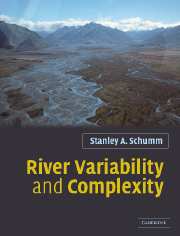Chapter 14 - Vegetation
Published online by Cambridge University Press: 05 June 2012
Summary
It appears intuitive that any vegetation (Figure 1.2) on the banks of a river will protect that bank from erosion. Numerous field studies support this contention. For example, following major floods in British Columbia it was determined that of 748 bends, those without riparian vegetation were five times as likely to have eroded, and major bank erosion was 30 times more prevalent on non-vegetated bends (Beeson and Doyle, 1995). Smith (1976) found in cold regions that heavily vegetated banks were 20000 times more resistant to erosion than non-vegetated banks. Ikeda and Izumi (1990) state that channels with dense vegetation will on average be 30 percent narrower than channels with little or no vegetation. However, if banks are high and they exceed the depth of roots, undercutting will cause bank failure. In addition, the weight of trees will accelerate failure especially if wind is a factor.
Hey and Thorne (1986) developed a series of equations relating channel width to discharge for different bank vegetation densities (Figure 14.1). Bank vegetation ranged from 0 percent trees and shrubs (Type 1), 1–5 percent (Type 2), 5–50 percent (Type 3), and greater than 50 percent trees and shrubs (Type 4):
Clearly, channel width was greater when trees and shrubs were lacking. Similar results were documented for small streams in New South Wales (Huang and Nanson, 1997). Along the banks of the Genesee River in New York, bends that encountered farmland migrated 30 percent faster than the bends that encountered forest land (Beck et al.
- Type
- Chapter
- Information
- River Variability and Complexity , pp. 133 - 137Publisher: Cambridge University PressPrint publication year: 2005



